The Basics
- Crochet stitches
- How to begin – to make a loop
- How to begin – what to do with the left hand
- How to begin – what to do with the right hand
- How to make chain stitches
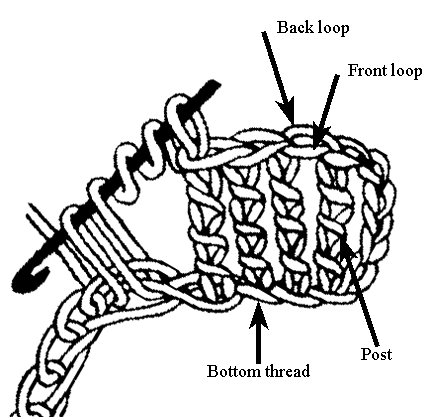
CROCHET STITCHES
All crochet stitches are based on the action of a loop pulled through another loop with a hook.
When crocheting, right handed people work from right to left.
When learning the basic steps, begin with 8ply yarn and a 3.50mm hook OR 4ply yarn and a 2.50mm hook, so that each stitch is clearly visible.
Practise the simple steps first before attempting the finer threads.
In all crocheting, pick up the two top threads of each stitch unless otherwise stated.
The two top threads consist of a front and a back loop.
HOW TO BEGIN TO CROCHET
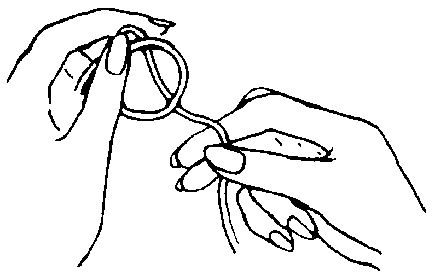
STEP 1.
TO MAKE A LOOP
1. Grasp the thread near the end between the thumb and the forefinger of the left hand.
2. With the right hand, make a loop by lapping the long thread over the short thread.
3. Hold this loop in place between the thumb and the forefinger of the left hand.
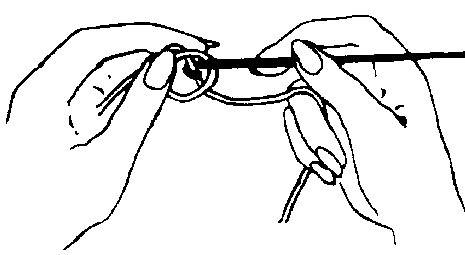
STEP 2.
1. With the right hand, take hold of the broad bar of the hook as you would a pencil.
2. Insert the hook through the loop and under the long thread. With the right hand, catch the long end of the thread. Draw the loop through.
3. Do not remove the hook from the thread.
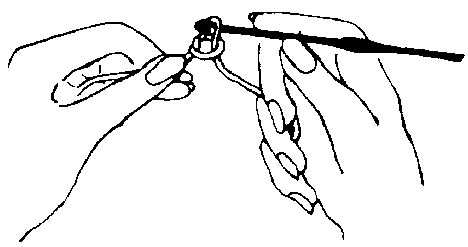
STEP 3.
1. Pull the short end and the ball thread in opposite directions to bring the loop around the end of the hook, but not too tight.
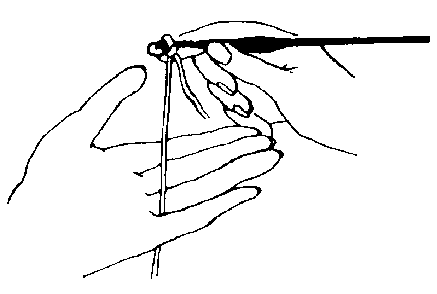
STEP 4.
WHAT TO DO WITH THE LEFT HAND
1. Measure with your eye about 10cm along the ball thread from the loop on the hook.
2. At about this point, insert the thread between the ring finger and the little finger, having the palm of the hand facing up.
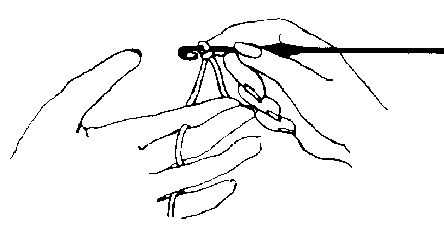
STEP 5.
1. Bring the thread towards the back, under the little finger and the ring finger, over the middle finger and under the forefinger towards the thumb.
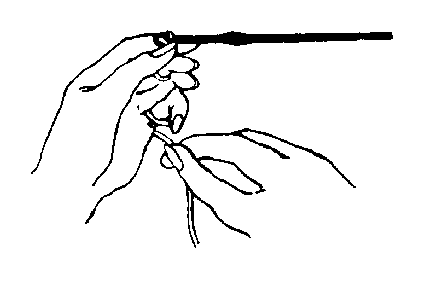
STEP 6.
1. Grasp the hook and the loop between the thumb and the forefinger of the left hand.
2. Gently pull the ball thread so that it lies around the fingers firmly, but not tightly.
3. Catch the knot of the loop between the thumb and the forefinger.
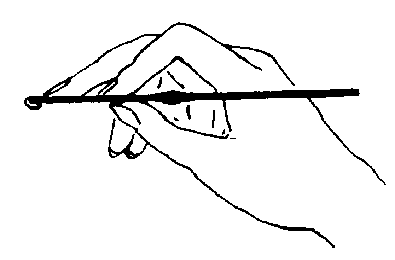
STEP 7.
WHAT TO DO WITH THE RIGHT HAND
1. Take hold of the broad bar of the hook as you would a pencil.
2. Bring the middle finger forward to rest near the tip of the hook.
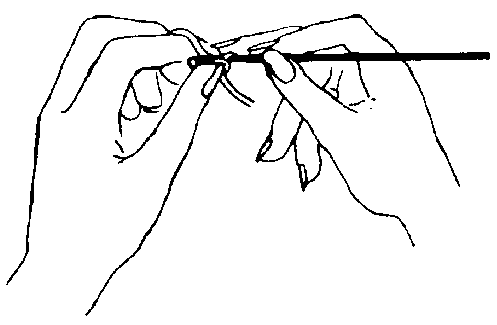
STEP 8.
1. Adjust the fingers of the left hand, the middle finger is bent to regulate the tension, the ring and the little fingers control the thread. The motion of the hook in the right hand and the thread in the left hand should be free and even. Ease comes with practice.
CHAIN (ch) is the basis of all crocheting. Chain is used to begin crocheting, to obtain height at the beginning of a row, and in patterns where an opening or a hole is required. When crocheting the starting row (foundation chain), work the chain stitches more loosely than the following rows.
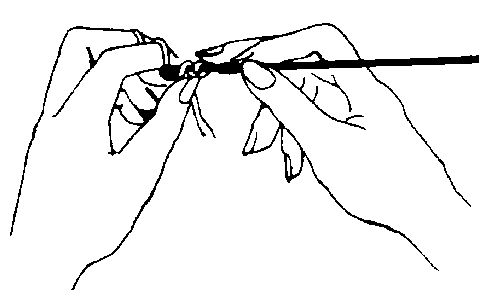
STEP 9.
CHAIN (ch)
1. Pass the hook under the thread and catch the thread with the hook. This is called “thread over” or yarn over hook.
2. Draw the thread through the loop on the hook. This makes one chain (ch). The loop on the hook is not counted as a stitch.
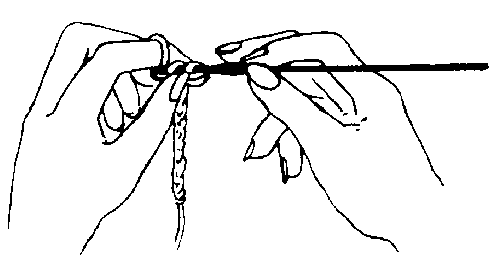
STEP 10.
1. Repeat Step 9 until you have as many chain (ch) as you need – one loop always remains on the hook.
2. Always keep the thumb and the forefinger of the left hand near the stitch on which you are working.
3. Practise making chain stitches until they are even in size.
SLIP STITCH (sl st)
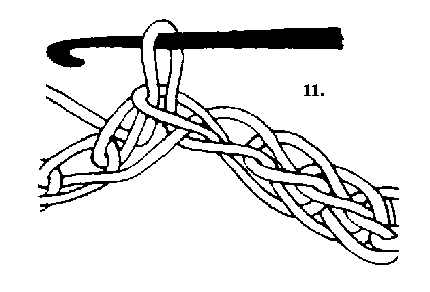 Slip stitching is used to move across the row without creating depth and to join rounds in circular crocheting.
Slip stitching is used to move across the row without creating depth and to join rounds in circular crocheting.
Insert the hook from the front, under the two top threads of the stitch next to the hook, thread over and draw it through the stitch AND the loop on the hook in one movement.
DOUBLE CROCHET (dc)
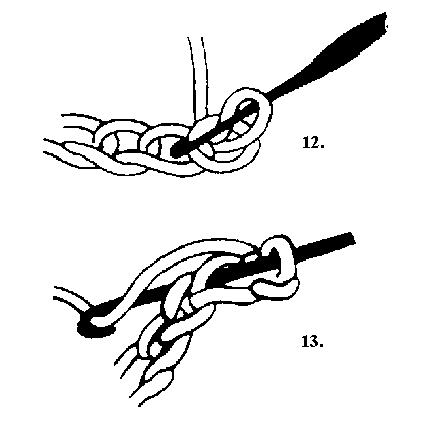
Make a length of chain, insert the hook from the front, under the two top threads of the 2nd chain from the hook. (Fig 12)
Thread over. (Fig 13)
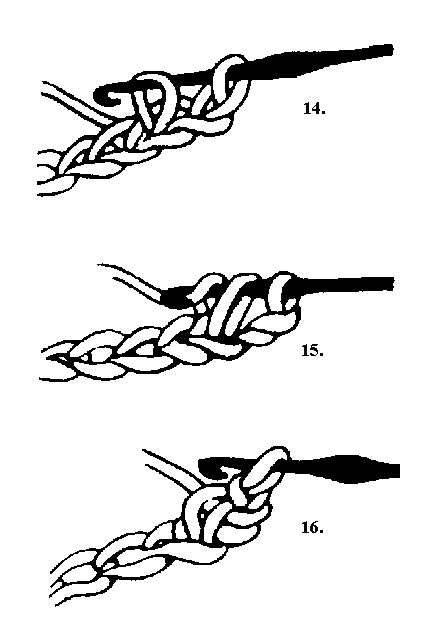
Draw it through the chain, there are now two loops on the hook. (Fig 14)
Thread over. (Fig 15)
Draw through the two loops, one loop will remain on the hook. One double crochet (dc) now completed. (Fig 16)
For next dc, insert the hook under the two top threads of the next stitch and repeat as before.
HALF TREBLE (htr)
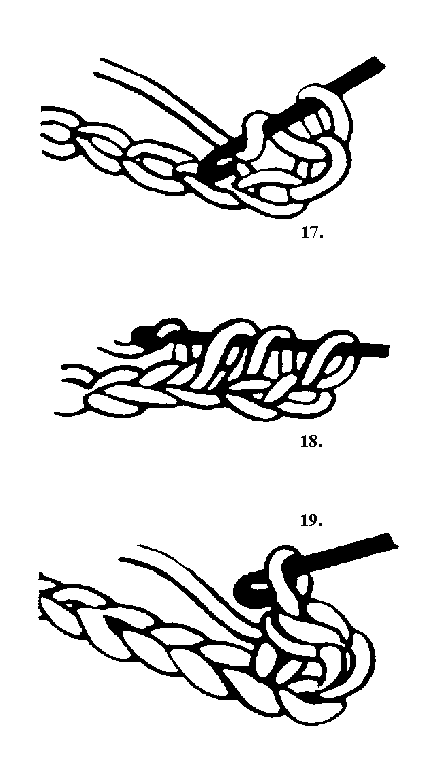
Make a length of chain, thread over, insert the hook from the front, under the two top threads of the 3rd ch from the hook (Fig 17).
Thread over, and draw it through this ch. There are now three loops on the hook, thread over (Fig 18), and draw it through all three loops, one loop will remain on the hook.
One half treble (1htr) completed (Fig 19).
For the next htr, thread over, insert the hook under the two top threads of the next ch and repeat as before.
TREBLE (tr)
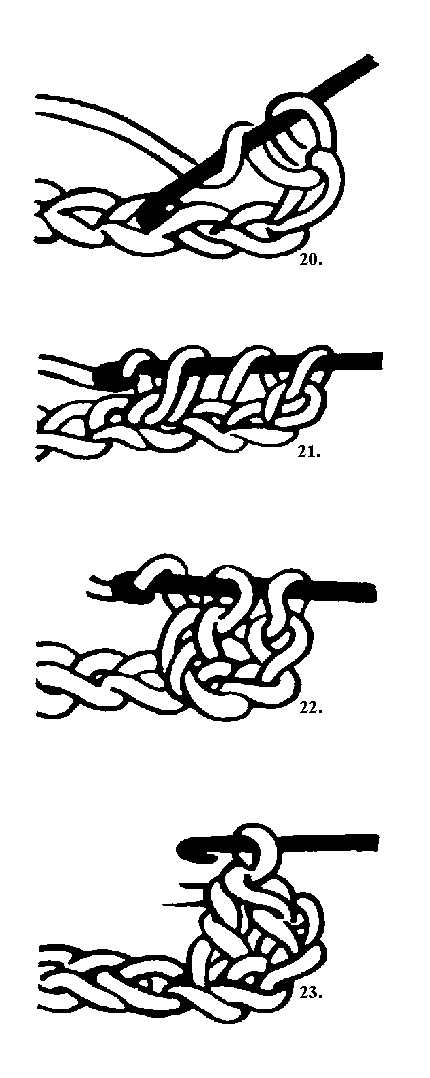
Make a length of chain, thread over, insert the hook from the front, under the two top threads of the 4th ch from the hook (Fig 20).
Thread over, and draw it through this ch. There are now 3 loops on the hook, thread over (Fig 21).
Now draw it through 2 loops, 2 loops will remain on the hook, thread over (Fig 22).
Now draw it through the remaining 2 loops, 1 loop will remain on the hook. One treble (1tr) completed (Fig 23).
For the next tr, thread over, insert the hook under the two top threads of the next ch and repeat as before.
DOUBLE TREBLE (dtr)
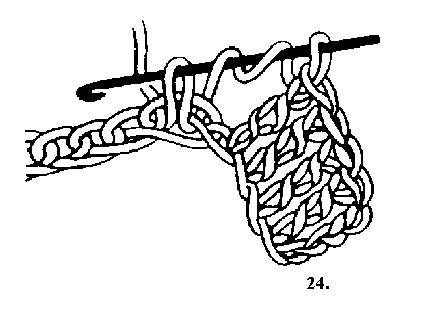
Make a length of chain, thread over twice, insert the hook from the front, under the two top threads of the 5th ch from the hook, thread over, and draw it through the ch. There are now 4 loops on the hook, thread over, and draw it through 2 loops, 3 loops will remain on the hook, thread over again, and draw it through 2 loops, 2 loops will remain on the hook, thread over again, and draw it through the remaining 2 loops, 1 loop will remain on the hook. One double treble (1dtr) now completed.
For next dtr, thread over twice, insert the hook under the two top threads of the next ch and repeat as before (Fig 24).
TRIPLE TREBLE (triptr)
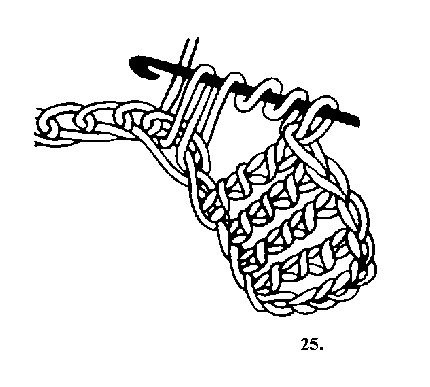
Make a length of chain, thread over three times, insert the hook from the front, under the two top threads of the 6th ch from the hook, thread over, and draw it through the ch. There are now 5 loops on the hook, thread over, and draw it through 2 loops, 4 loops will remain on the hook, thread over again, and draw it through 2 loops, 3 loops will remain on the hook, thread over again, and draw it through 2 loops, 2 loops will remain on the hook, thread over again, and draw it through the remaining 2 loops, 1 loop will remain on the hook. One triple treble (triptr) now completed.
For next triptr, thread over three times, insert the hook under the two top threads of the next ch and repeat as before (Fig 25).
QUADRUPLE TREBLE (quadtr)
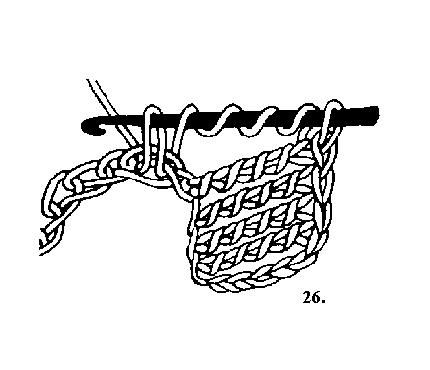
Make a length of chain, thread over four times, insert the hook from the front, under the two top threads of the 7th ch from the hook, thread over, and draw it through the ch. There are now 6 loops on the hook, thread over, and draw it through 2 loops, 5 loops will remain on the hook, thread over again, and draw it through 2 loops, 4 loops will remain on the hook, thread over again, and draw it through 2 loops, 3 loops will remain on the hook, thread over again, and draw it through 2 loops, 2 loops will remain on the hook, thread over again, and draw it through the remaining 2 loops, 1 loop will remain on the hook. One quadruple treble (1quadtr) now completed.
For the next quadtr, thread over four times, insert the hook under the two top threads of the next ch and repeat as before (Fig 26).
QUINTUPLE TREBLE (quintr)
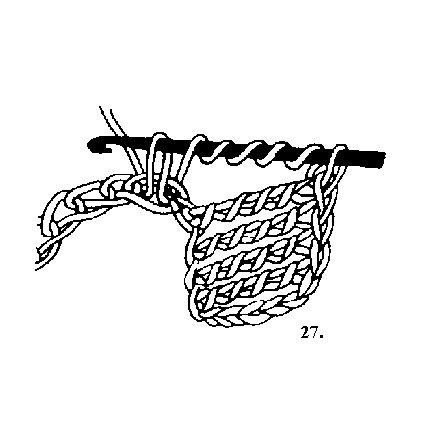
Make a length of chain, thread over five times, insert the hook from the front, under the two top threads of the 8th ch from the hook, thread over, and draw it through the ch. There are now 7 loops on the hook, thread over, and draw it through 2 loops, 6 loops will remain on the hook, thread over again, and draw it through 2 loops, 5 loops will remain on the hook, thread over again, and draw it through 2 loops, 4 loops will remain on the hook, thread over again, and draw it through 2 loops, 3 loops will remain on the hook, thread over again, and draw it through 2 loops, 2 loops will remain on the hook, thread over again, and draw it through the remaining 2 loops, 1 loop will remain on the hook. One quintuple treble (1quintr) now completed.
For next quintuple tr, thread over five times, insert the hook under the 2 top threads of the next ch and repeat as before (Fig 27).
READING PATTERNS
If the pattern is written in rows, crochet the first row then turn the work, continue the next row to the end, turn the work again and then proceed with the 3rd and following rows, turning at the end of each row.
If the pattern is written in rounds, crochet the first round, ending with a slip stitch into the top of the beginning stitch of the round. DO NOT TURN the work between rounds.
When the instructions are inside a bracket, repeat them as many times as specified, for example (5ch, 1dc in next dc) 6 times, this means to work all in the brackets 6 times only.
An * (asterisk) in a pattern means that the instruction after the * is repeated as many times as specified, in addition to the original instruction that followed the asterisk. For example, (Miss 2tr, * 1tr in next tr, 5ch; repeat from * to last 1tr, 1tr in last tr), means to miss the first 2tr, then work 1tr in the next tr and make 5ch, then continue to repeat doing 1tr in the next tr and 5ch until 1tr remains, then work 1tr in the last tr.
INCREASING
Precise instructions for increasing are usually given in each pattern. However, a simple increase will consist of working two stitches (instead of one), into one stitch of the previous row. This may be done at either end of the row or in any part of the row. The pattern will usually specify the correct procedure. Refer to example.
DECREASING
When decreasing, the pattern will specify the method to be used.
“Miss one stitch” – miss the next stitch and work into the following stitch. This will decrease the number of stitches by one. Also referred to as “skip 1” in some patterns.
“Work 2sts tog” – (work 2 stitches together) This is achieved by not finishing either of the next 2 stitches, but leaving the last loop of each stitch on the hook in addition to the loop already on the hook. Thread over, and pull the yarn through all the loops to form 1 loop on the hook. This produces a less obvious space.
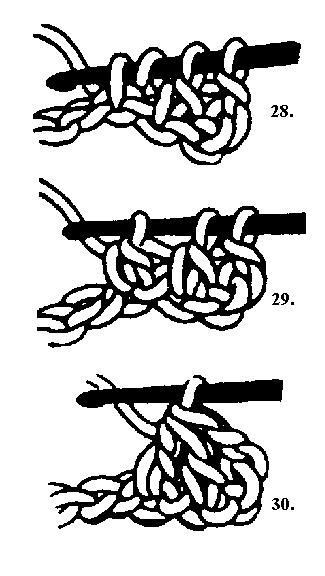
For example to “work 2sts tog” or decrease over treble, complete the first treble to the point where there are 2 loops on the hook. Work the next treble until there are 4 loops on the hook (Fig 28).
Thread over and draw the thread through 2 loops (Fig 29), thread over again and draw the thread through the remaining 3 loops. One loop remains on the hook. This is often referred to as treble decrease or decrease treble. (Fig 30)
When decreasing at the beginning of a row, simply slip stitch over the required number of stitches to be decreased, then work the turning chain and continue the row.
When decreasing at the end of a row, work to within the number of stitches to be decreased, turn work and continue the next row.
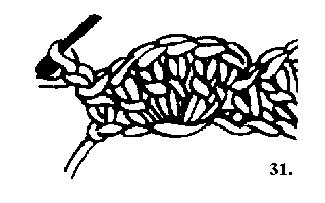
Increases and decreases in stitches and changing the type of stitch are the basis of all patterns. For example, 1dc in next st, miss 2sts, 5tr in next st, miss 2sts, 1dc in next st (Fig 31), forms a shell design.
CROCHETING IN ROWS
Make a length of chain (foundation chain). Depending on the stitch to be used, extra chain will need to be added to form the height of the stitch. These chain count as the first stitch unless otherwise stated. Some patterns say to “miss” a certain number of stitches at the beginning of the first row. This also gives the required height. Use the table below as a guide.
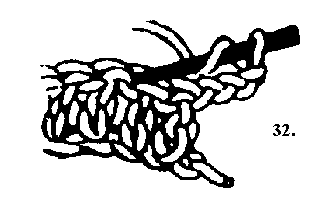
When crocheting in rows, for example in trebles, work a foundation row and when the last treble is completed, turn the work so that the reverse side is facing. Work 3 chain (turning chain) for height, and because the turning chain will count as the first stitch of this new row, miss the last worked stitch of the previous row and work the next treble into the top of the next treble (Fig 32).
Remember to always insert the hook under the two top threads of each stitch, unless the pattern states otherwise.
Continue across the row. The last treble of the row will be worked into the top of the turning chain, that is, into the 3rd chain of the beginning 3ch of the last row.
Some patterns, in which the turning chain does not count as the first stitch at the beginning of the row, require you to work into the last stitch of the previous row, and in this case you do not work a stitch into the turning chain at the end of the row.
The turning chain table is used as a guide only when determining the number of stitches required for a turning chain. Depending on the type and texture of thread / yarn used, the number of chain can be varied. Similarly, rows of dc, htr, dtr, and other sts are worked, varying the height of the turning chain.
| Stitch used in row | Turning chain |
| double crochet | 1ch |
| half treble | 2ch |
| treble | 3ch |
| double treble | 4ch |
| triple treble | 5ch |
| quadruple treble | 6ch |
| quintuple treble | 7ch |
BREAK OFF
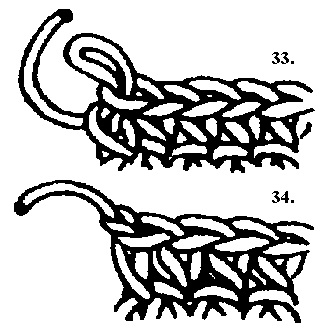
BREAK OFF is to finish off or end off. Simply cut the thread about 8 – 10cm long. Bring the cut end through the last remaining loop on the hook and pull tightly (Figs 33 and 34). Weave this end back into the main part of the work with a blunt needle.
TO CROCHET IN ROUNDS
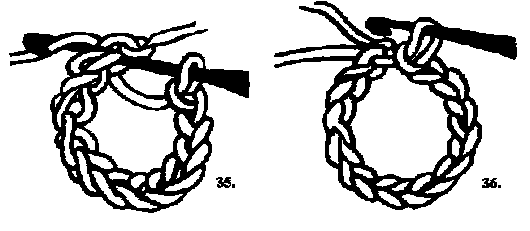
When crocheting in rounds, unless stated in the pattern, never turn the work between the rounds. Each stitch is still worked under the two top threads of the stitch in the previous round. A “right side” will be noticeable in the crocheted piece. Rounds are joined with a slip stitch (sl st) [Figs 35 and 36]. Rounds can be worked in a variety of stitches. The example below is worked in treble only.
To begin, make 4ch. Join with a sl st into the first ch to form a ring. Do not twist the work.
Round 1. 3ch, (this is for height and will count as one st). Work 11 treble into the centre of the ring. Join the round with a
sl st into the 3rd ch of the beginning 3ch. (12tr)
Round 2. 3ch, 1tr in same place as sl st, 2tr in each of the other tr, join the round with a sl st into the 3rd ch of the beginning 3ch. (24tr) This is increasing in every stitch.
In the next round the stitches must be increased evenly, so proceed as follows:
Round 3. 3ch, * 2tr in next tr, 1tr in the next tr; repeat from * to last st, 2tr in this st. Join the round with a sl st into the 3rd ch of the beginning 3ch. (36tr) The increase was made in every second stitch.
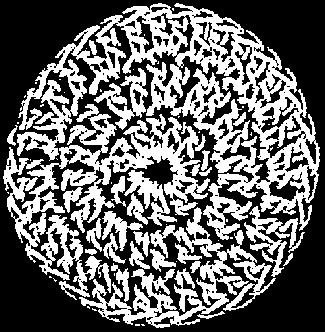
Increasing is achieved by working a required number of stitches into one stitch. Most patterns state when to increase and the method to use. The aim is to increase at a rate that allows the crocheting to remain flat.
Variations of terminology:
“Round 1” may read “1st round”, and “into the 3rd ch of the beginning 3ch” may read “into the top of the turning ch”.
CLUSTERS AND POPCORNS are commonly used in edges, motifs and patterns. Any number of stitches can be used and so can any combinations of any type of stitch. It is common for most patterns to use the one stitch for height.
CLUSTERS (cl)
A cluster may vary from two to six stitches. It may be worked over a given number of stitches, into one stitch or into a space. Following are examples of these variations.
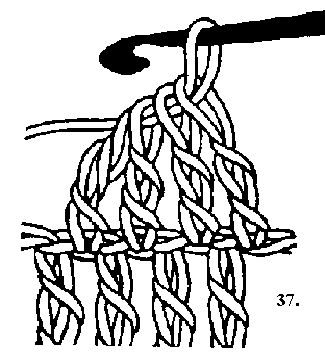
1. A 4dtr cluster over 4 stitches. Leaving the last loop of each stitch on the hook, work 1dtr into each of the following 4 stitches, thread over hook and draw it through all the remaining 5 loops on the hook (Fig 37).
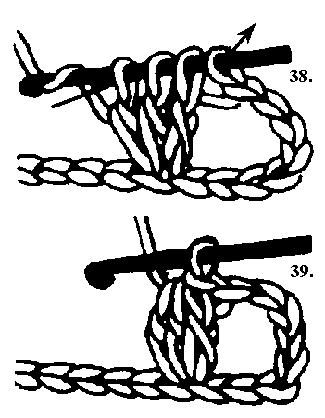
2. A 3tr cluster worked into one stitch. Leaving the last loop of each stitch on the hook, work 3tr into the one stitch, thread over hook, pull through all 4 loops on the hook (Figs 38 and 39).
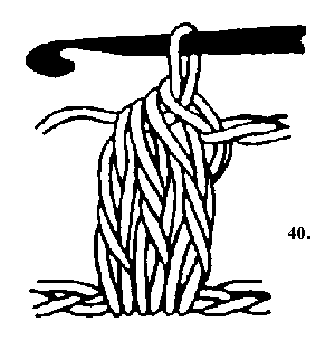
3. A 3dtr cluster worked into a space or loop. Leaving the last loop of each stitch on the hook, work 3dtr into the space of the previous row, thread over hook and draw it through all the remaining 4 loops on the hook (Fig 40).
POPCORN
A popcorn is a group of three or more stitches worked into the same stitch of the previous row and is completed as follows:
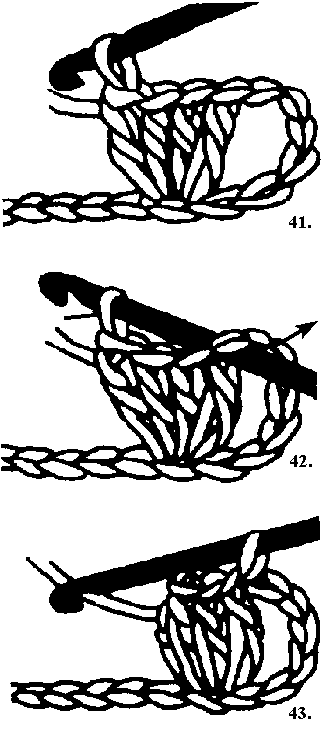
To make a 4tr popcorn. Work 4tr into the same stitch (Fig 41).
Remove the loop from the hook, insert the hook into the top of the first treble of this group, then into the loop just dropped (Fig 42).
Pull the loop through the first treble (Fig 43). A popcorn is usually, but not always, followed by 1 or more chain to define the popcorn.
